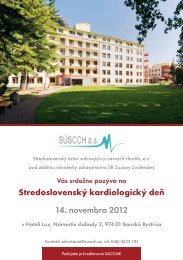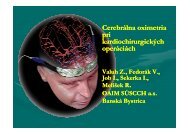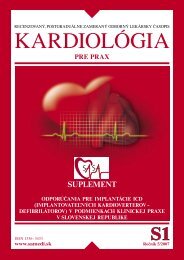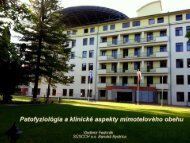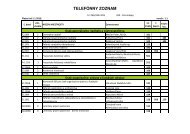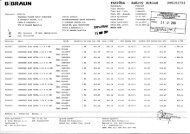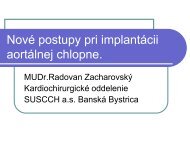Management of acute myocardial infarction in patients presenting ...
Management of acute myocardial infarction in patients presenting ...
Management of acute myocardial infarction in patients presenting ...
You also want an ePaper? Increase the reach of your titles
YUMPU automatically turns print PDFs into web optimized ePapers that Google loves.
ESC Guidel<strong>in</strong>es 2935<br />
8. Angiotens<strong>in</strong>-convert<strong>in</strong>g enzyme<br />
<strong>in</strong>hibitors and angiotens<strong>in</strong> receptor<br />
blockers<br />
Several trials have established that ACE-<strong>in</strong>hibitors reduce mortality<br />
212 – 215<br />
after STEMI with reduced residual LV function (,40%).<br />
There is a strong case for adm<strong>in</strong>ister<strong>in</strong>g ACE-<strong>in</strong>hibitors to <strong>patients</strong><br />
who have experienced heart failure <strong>in</strong> the <strong>acute</strong> phase, even if no<br />
features <strong>of</strong> this persist, who have an EF <strong>of</strong> 40%, or a wall motion<br />
<strong>in</strong>dex <strong>of</strong> 1.2, provided there are no contra<strong>in</strong>dications. As discussed<br />
above, there is also a case for adm<strong>in</strong>ister<strong>in</strong>g ACE-<strong>in</strong>hibitors<br />
to all <strong>patients</strong> with STEMI from admission, provided there are no<br />
contra<strong>in</strong>dications. 143,144,216 Aga<strong>in</strong>st such a policy is the <strong>in</strong>creased<br />
<strong>in</strong>cidence <strong>of</strong> hypotension and renal failure <strong>in</strong> those receiv<strong>in</strong>g<br />
ACE-<strong>in</strong>hibitors <strong>in</strong> the <strong>acute</strong> phase, and the small benefit <strong>in</strong> those<br />
at relatively low risk, such as <strong>patients</strong> with small <strong>in</strong>ferior <strong><strong>in</strong>farction</strong>s.<br />
In favour are observations from studies <strong>in</strong> populations with stable<br />
cardiovascular disease but without LV dysfunction show<strong>in</strong>g beneficial<br />
effects, <strong>in</strong>clud<strong>in</strong>g a reduction <strong>in</strong> mortality and stroke. 217–219<br />
Use <strong>of</strong> ACE-<strong>in</strong>hibitors should be considered <strong>in</strong> all <strong>patients</strong> with<br />
atherosclerosis, but, given the relatively modest effect, their longterm<br />
use cannot be considered to be mandatory <strong>in</strong> post-STEMI<br />
<strong>patients</strong> who are normotensive, without heart failure or compromised<br />
systolic LV function.<br />
Two trials have evaluated ARBs <strong>in</strong> the context <strong>of</strong> STEMI as<br />
alternatives to ACE-<strong>in</strong>hibitors: the OPTIMAAL trial with losartan<br />
(50 mg) failed to show superiority or non-<strong>in</strong>feriority over captopril<br />
(50 mg three times daily). 220 Conversely, the VALIANT trial compared<br />
valsartan alone (160 mg twice daily), full-dose captopril<br />
(50 mg three times daily), or both (80 mg twice daily and 50 mg<br />
three times daily). Mortality was similar <strong>in</strong> the three groups, but<br />
discont<strong>in</strong>uations were more frequent <strong>in</strong> the groups receiv<strong>in</strong>g captopril.<br />
221 Therefore, valsartan <strong>in</strong> dosages as used <strong>in</strong> the trial<br />
represents an alternative to ACE-<strong>in</strong>hibitors <strong>in</strong> <strong>patients</strong> who do<br />
not tolerate ACE-<strong>in</strong>hibitors and have cl<strong>in</strong>ical signs <strong>of</strong> heart failure<br />
and/or an EF 40%.<br />
9. Aldosterone blockade<br />
The EPHESUS trial randomized 6642 post-STEMI <strong>patients</strong> with LV<br />
dysfunction (EF 40%) and heart failure or diabetes to eplerenone,<br />
a selective aldosterone blocker, or placebo. After a mean<br />
follow-up <strong>of</strong> 16 months, there was a 15% relative reduction <strong>in</strong><br />
total mortality and a 13% reduction <strong>in</strong> the composite <strong>of</strong> death<br />
and hospitalization for cardiovascular events. 222 However,<br />
serious hyperkalaemia was more frequent <strong>in</strong> the group receiv<strong>in</strong>g<br />
eplerenone. The results suggest that aldosterone blockade may<br />
be considered for post-STEMI <strong>patients</strong> with an EF ,40% and<br />
heart failure or diabetes provided that creat<strong>in</strong><strong>in</strong>e is ,2.5 mg/dL<br />
<strong>in</strong> men and 2.0 mg/dL <strong>in</strong> women, and potassium is 5.0 mEq/L.<br />
Rout<strong>in</strong>e monitor<strong>in</strong>g <strong>of</strong> serum potassium is warranted and should<br />
be particularly careful when other potential potassium-spar<strong>in</strong>g<br />
agents are used.<br />
10. Blood pressure control<br />
Accord<strong>in</strong>g to the ESC Guidel<strong>in</strong>es for the management <strong>of</strong> arterial<br />
hypertension the goal is to achieve a blood pressure ,130/<br />
80 mmHg <strong>in</strong> <strong>patients</strong> with stroke, <strong>myocardial</strong> <strong><strong>in</strong>farction</strong>, renal<br />
disease, and diabetes. 223 Pharmacotherapy recommended post-<br />
STEMI (b-blockers, ACE-<strong>in</strong>hibitors, or ARBs) will help to achieve<br />
these goals, <strong>in</strong> addition to lifestyle modification with respect to<br />
physical activity and weight loss. Additional pharmacotherapy<br />
may be needed.<br />
11. <strong>Management</strong> <strong>of</strong> diabetes<br />
Glucometabolic disturbances are common <strong>in</strong> <strong>patients</strong> with coronary<br />
disease and should be actively searched for. S<strong>in</strong>ce an abnormal<br />
glucose tolerance test is a significant risk factor for future cardiovascular<br />
events after <strong>myocardial</strong> <strong><strong>in</strong>farction</strong>, 224 it seems mean<strong>in</strong>gful<br />
to perform such a test before or shortly after discharge. 225<br />
In <strong>patients</strong> with established diabetes, the aim is to achieve<br />
HbA1c levels 6.5%. This calls for <strong>in</strong>tensive modification <strong>of</strong> lifestyle<br />
(diet, physical activity, weight reduction), usually <strong>in</strong> addition<br />
to pharmacotherapy. Coord<strong>in</strong>ation with a physician specialized <strong>in</strong><br />
diabetes is advisable. In <strong>patients</strong> with impaired fast<strong>in</strong>g glucose<br />
level or impaired glucose tolerance, only lifestyle changes are currently<br />
recommended. 225<br />
12. Interventions on lipid pr<strong>of</strong>ile<br />
Several trials have unequivocally demonstrated the benefits <strong>of</strong><br />
long-term use <strong>of</strong> stat<strong>in</strong>s <strong>in</strong> the prevention <strong>of</strong> new ischaemic<br />
events and mortality <strong>in</strong> <strong>patients</strong> with coronary heart disease. The<br />
targets established by the Fourth Jo<strong>in</strong>t Task Force <strong>of</strong> the ESC<br />
and other societies <strong>in</strong> <strong>patients</strong> after <strong><strong>in</strong>farction</strong> are: for total cholesterol,<br />
175 mg/dL (4.5 mmol/L) with an option <strong>of</strong> 155 mg/dL<br />
(4.0 mmol/L) if feasible, and for lower LDL cholesterol 100 mg/<br />
dL (2.5 mmol/L) with an option <strong>of</strong> 80 mg/dL (2.0 mmol/L) if feasible.<br />
183 Although pharmacological treatment is highly efficient <strong>in</strong><br />
treat<strong>in</strong>g dyslipidaemia <strong>in</strong> heart disease, diet rema<strong>in</strong>s a basic requirement<br />
for all <strong>patients</strong> with coronary heart disease. The most recent<br />
controversy on lipid-lower<strong>in</strong>g treatment has been focused on<br />
<strong>in</strong>tensive, vs. standard lipid-lower<strong>in</strong>g therapy. A recent<br />
meta-analysis <strong>of</strong> randomized controlled trials that compared different<br />
<strong>in</strong>tensities <strong>of</strong> stat<strong>in</strong> therapy identified a total <strong>of</strong> seven trials,<br />
with a total <strong>of</strong> 29 395 <strong>patients</strong> with coronary artery disease. 226<br />
Compared with less <strong>in</strong>tensive stat<strong>in</strong> regimens, more <strong>in</strong>tensive regimens<br />
further reduced LDL cholesterol levels and reduced the risk<br />
<strong>of</strong> <strong>myocardial</strong> <strong><strong>in</strong>farction</strong> and stroke. Although there was no effect<br />
on mortality among <strong>patients</strong> with chronic coronary artery disease<br />
[odds ratio (OR) 0.96, 95% confidence <strong>in</strong>terval (CI) 0.80–1.14], allcause<br />
mortality was reduced among <strong>patients</strong> with <strong>acute</strong> coronary<br />
syndromes treated with more <strong>in</strong>tensive stat<strong>in</strong> regimens (OR<br />
0.75, 95% CI 0.61–0.93). All seven trials reported events by randomization<br />
arm rather than by LDL cholesterol level achieved.<br />
About half <strong>of</strong> the <strong>patients</strong> treated with more <strong>in</strong>tensive stat<strong>in</strong><br />
therapy did not achieve an LDL cholesterol level <strong>of</strong> ,80 mg/dL<br />
(2.0 mmol/L), and none <strong>of</strong> the trials tested comb<strong>in</strong>ation therapies.<br />
The analysis supports the use <strong>of</strong> more <strong>in</strong>tensive stat<strong>in</strong> regimens <strong>in</strong><br />
<strong>patients</strong> with established coronary artery disease. There is <strong>in</strong>sufficient<br />
evidence to advocate treat<strong>in</strong>g to particular LDL cholesterol<br />
targets, us<strong>in</strong>g comb<strong>in</strong>ation lipid-lower<strong>in</strong>g therapy to achieve<br />
these targets.<br />
In <strong>patients</strong> who do not tolerate stat<strong>in</strong>s, or who have contra<strong>in</strong>dications,<br />
other lipid-lower<strong>in</strong>g therapy may be warranted. In a study<br />
with gemfibrozil (a fibrate), 227 <strong>patients</strong> with HDL cholesterol levels



